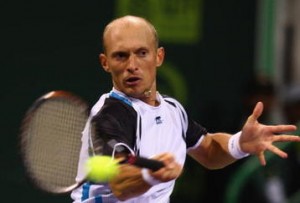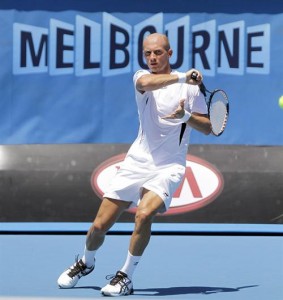Nikolay Davydenko: Don’t Call Him a Dark Horse

Nikolay Davydenko could be a factor in the 2010 Australian Open.
Nikolay Davydenko has been regarded with a mixture of awe and sympathy for many years.
He announced himself as a factor in the 2005 Australian Open, after causing a minor, yet noticeable jolt to the draw by pounding Tim Henman and Guillermo Cañas in succession. In the quarters of that event, he faced Andy Roddick, who was then No. 2 in the world.
Even then it was hard not be amazed at his shots: Time and time again he spun in his first serves, rarely winning points outright with them, but forcing Roddick to cough up a ball landing at midcourt which the Russian could crush. And that’s what he did, sending a host of forehand winners past the American.
Victory was not to be his that day, as Roddick was holding serve easily, and his returns eventually started landing deep enough to prolong the rallies, which eventually contributed to mistakes on the Russian’s side. Though he lost in straight sets that day, Davydenko announced that he was one of the best pure ballstrikers in the world.
And that pure hitting allowed him to reach the top 10 that year, and stay in the top 10 ever since. In an era where the players are ever bigger and more imposing, Davydenko is 5’10” – the only man under 6 feet in the current top 10 – and perhaps generously listed at 154 pounds by the ATP Tour website. What’s more, his thinning tufts of blond hair have always reminded of a freshly hatched chick.
But there is no denying the strokes: With Andre Agassi and Marat Safin retired, and David Nalbandian only on tour for part of the year, Davydenko now must be considered the purest hitter in the game. Whereas Rafael Nadal or Juan Martin del Potro must wind to uncork their forehands, the Russian’s swings are compact and find the sweet spot on the racket each time.
Nadal or del Potro may generate more pace and spin when they get a shot they can really take hold of, but it’s easier for Davydenko find himself in proper positioning to really drive the ball thanks to his uncanny timing. Because he moves so quickly around the court it takes some awfully big shots to move him out of place, and his ability to take the ball early allows him to rob his opponents of precious seconds they need to set up their groundstrokes.

Davydenko has reached the quarterfinals at the Australian Open three times, but not since 2007.
Yet until now he has not been taken seriously as a threat to win majors. He has twice been a semifinalist at Roland Garros and the US Open – in 2005 he let a two sets to one lead against Mariano Puerta evaporate in Paris, and on the other three occasions his defeat came from none other than Roger Federer.
Through these defeats we have seen shortcomings that even speed and remarkably good hitting have not been able to overcome, and this is where the sympathy comes in. One problem is his difficulty in closing matches – not only against Puerta, but against Tommy Haas in the 2007 Australian Open, Ivan Ljubicic in the 2008 Roland Garros, and both Nadal and James Blake at the 2006 Masters Cup – he has let many opportunities slip away.
This may contribute to his other problem – his image as a lightweight. There are many other factors at play here: Davydenko’s lack of a serving weapon forces him to work harder than many others in the top 10, he tends toward self-deprecation in interviews, and he has to look up at pretty much all of his opponents during the opening coin toss.
The fact remains, though, that Davydenko needs a big-time win to be seen as a big-time player, and at times that seems to be all he is lacking to be considered a contender. At Roland Garros in 2007 he had opportunities against Federer in all three sets, and yet went home without winning any of them.
Opponents ought to be looking at him at least a little differently going into this year’s AO, however: He has won the last two tournaments he has played, the first of which was the World Tour Finals in London to finish the 2009 season. Between there and in the season-opener in Doha, Davydenko has beaten Federer and Nadal twice each. He also beat US Open champion del Potro in the World Tour Finals, and if you go back to his October victory in Shanghai, you may add a win over world No. 3 Novak Djokovic and a third over Nadal.
He will certainly be the favorite to reach the quarters in Melbourne, though former No. 1 Carlos Moya may test him in round two. If he holds up, his opponent will almost certainly be Federer, who hasn’t lost before the semis of a major in nearly seven years. The man from Basel would be the favorite to win that encounter – despite two consecutive losses, he’s still 12-2 against the Russian and has a proven track record in best-of-five set matches.
But unlike in their US Open semifinal showdowns, one gets the sense that Federer’s name hasn’t already been penciled into the next round. Davydenko is the hottest player on tour at the moment, and the past few months have shown that when he’s hot he can hit anyone off the court.
So, with his track record, and his world No. 6 ranking, one can’t call the Russian the AO dark horse; maybe more off-white.









